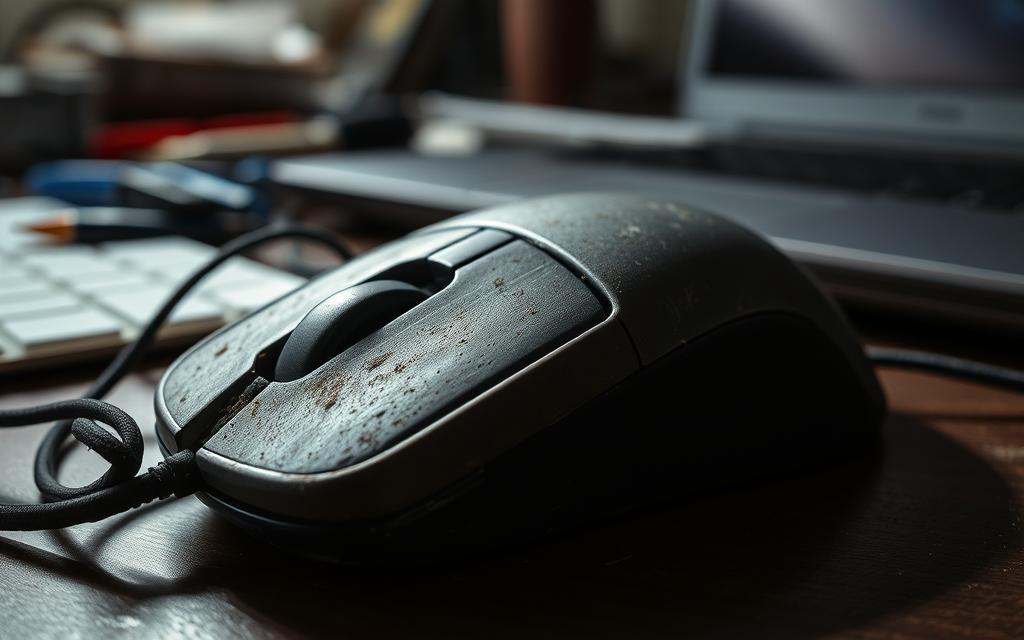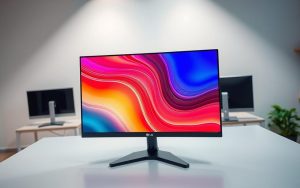Table of Contents
Do Wired Computer Mice Wear Out Over Time?
Many users wonder about the lifespan of wired peripherals, especially when relying on them daily. Unlike wireless alternatives, wired models often promise better durability due to their stable connection and robust build. But how long do they truly last?
Premium gaming devices, for instance, boast impressive ratings—some endure 20 million clicks before showing signs of wear. High-grade materials and precise engineering contribute to this longevity, offering 2-5 years of reliable performance.
Usage habits and maintenance play crucial roles. Heavy gaming or intense office work accelerates wear, while proper care extends functionality. Comparing wired and wireless options reveals key differences in lifespan expectations.
This article explores factors affecting durability, from build quality to real-world usage scenarios. We’ll also share practical tips to maximize your device’s lifespan.
Understanding Mouse Longevity: Do Corded Computer Mice Wear Out?
Wired mice often outlast wireless models, but what determines their lifespan? On average, these peripherals last 3–5 years with proper care—nearly double the lifespan of many wireless alternatives. However, durability hinges on build quality, usage intensity, and environmental factors.
The Fundamental Question Answered
Mechanical wear is inevitable. Studies show 50% of failures stem from cable damage, while 30% involve button responsiveness. Premium brands like Logitech use reinforced cables and higher-grade switches, extending usability.
Key Factors Affecting Wired Mouse Lifespan
Gaming mice endure 5x more clicks than office models, accelerating wear. Dust exposure and rough surfaces also degrade components faster. Budget options may save money upfront but often lack durable materials.
Manufacturer warranties hint at expected longevity. Top-tier models typically offer 2–3 years of coverage, reflecting confidence in their quality. User reports from tech forums align with these estimates, though heavy use can shorten timelines.
Internal Components That Degrade Over Time
Inside every wired mouse, critical components face gradual wear and tear. While cables often get blamed, microswitches, scroll wheels, and sensors quietly determine longevity. Understanding these parts helps users anticipate failures and choose durable models.
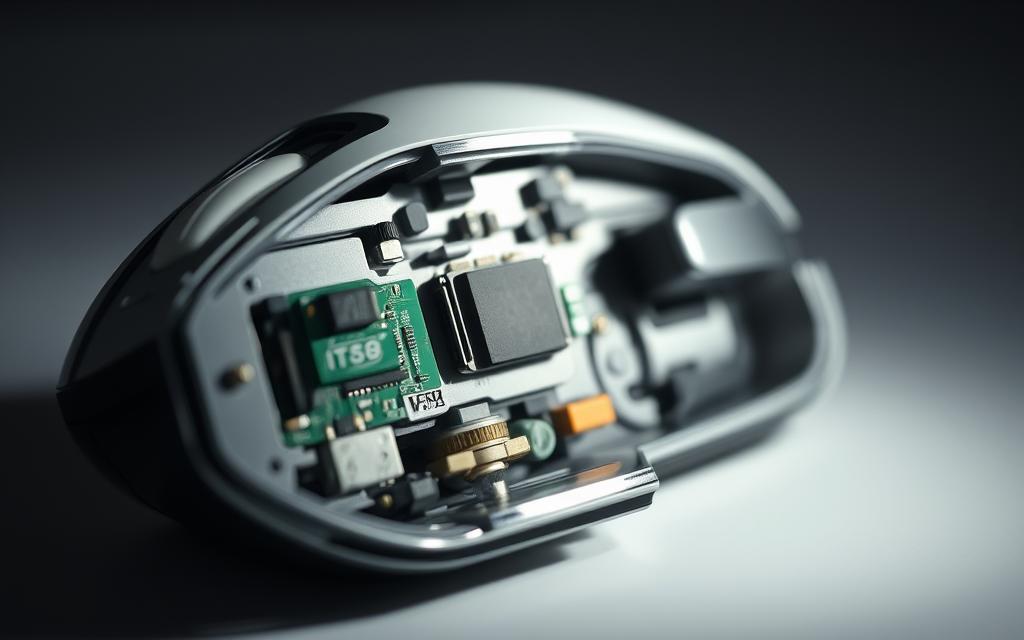
Microswitch Durability and Click Ratings
Buttons rely on microswitches—tiny mechanisms rated for millions of clicks. Omron switches, common in premium mice, endure 20M–50M actuations. Budget alternatives like Huano or generic brands may fail after 5M–10M.
Gaming mice face the harshest tests. A study found they endure 5x more clicks than office peripherals. Click ratings reflect lab tests under ideal conditions—real-world dust and humidity reduce these numbers.
| Switch Type | Click Rating | Common Use |
|---|---|---|
| Omron (Japan) | 20M–50M | Gaming, premium office |
| Huano | 10M–20M | Mid-range models |
| Generic | 5M–10M | Budget devices |
Scroll Wheel Mechanism Wear
The wheel uses encoders—either mechanical or optical. Mechanical versions wear faster, developing “jumpy” scrolling after 1–2 years. Optical encoders, found in high-end models, resist dust and last longer.
Heavy users notice wheel degradation first. Tactile feedback weakens, and scrolling becomes inconsistent. Cleaning helps, but encoder replacement often requires soldering.
Sensor Degradation Patterns
Sensors rarely fail outright but lose precision. Laser types suffer from dust accumulation, while optical sensors degrade slower. Gaming-grade sensors self-clean through rapid movement, extending accuracy.
Signs of sensor wear include:
- Cursor stuttering or acceleration issues
- Inconsistent tracking on smooth surfaces
- Delayed response during rapid movements
Manufacturers recommend quarterly sensor cleaning with compressed air. Avoid alcohol—it damages lens coatings.
External Vulnerabilities of Wired Mice
While internal parts degrade over time, external vulnerabilities often dictate a wired mouse’s lifespan. Cables, connectors, and surface contact points face daily stress, leading to 68% of failures according to hardware studies. Proactive maintenance can mitigate these issues.
Cable Stress Points and Failure Modes
Rubber-coated wires fray near connector joints, especially with frequent bending. Braided cables last longer but cost more. Aftermarket strain relief sleeves reduce problem areas by 40%.
DIY repairs like re-soldering frayed wires are possible but require technical skill. For most users, replacement proves more reliable.
USB Connector Wear and Tear
Repeated plugging/unplugging loosens USB ports over time. Gold-plated connectors resist corrosion better than standard ones. Test continuity with a multimeter if connectivity issues arise.
Surface Contact and Feet Deterioration
Heavy use wears down PTFE glide feet in 6–18 months. Hard surfaces like glass accelerate wear versus cloth pads. OEM replacements ensure fit, but third-party options work for budget-conscious users.
- Soft pads: Reduce friction but collect debris faster.
- Hard pads: Last longer but may scratch surfaces.
Signs Your Wired Mouse Is Failing
Your mouse gives subtle warnings before complete failure—learn to recognize them. Early detection saves time and prevents workflow disruptions. We’ll explore hardware and software symptoms across three critical areas.
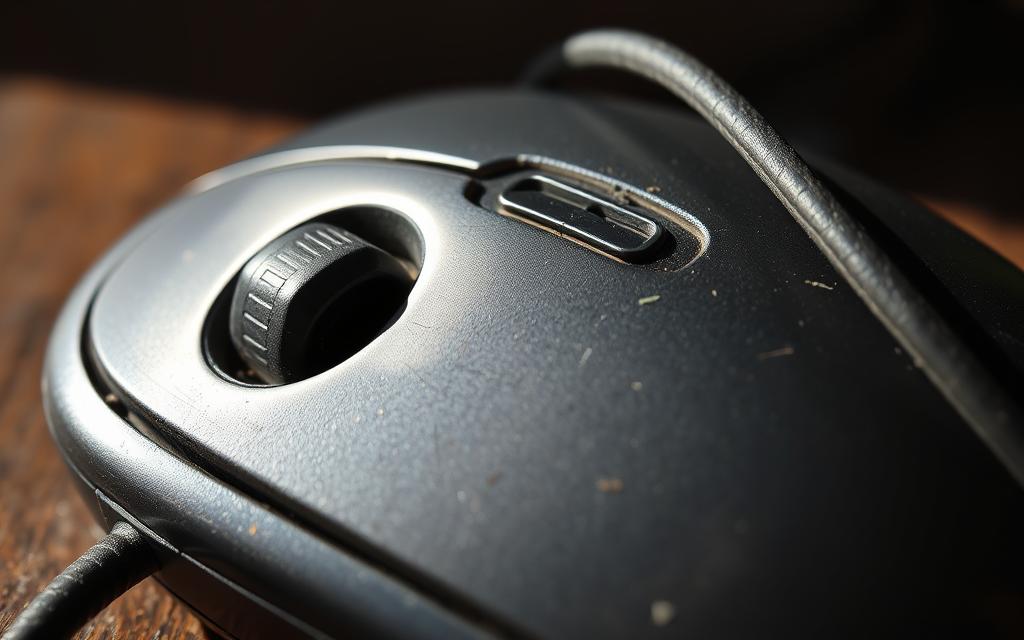
Intermittent Connectivity Issues
Random disconnections often stem from cable damage near the USB connector. Test continuity with a multimeter—resistance above 1Ω indicates wire fractures. Temporary fixes include:
- Adjusting cable position to maintain connection
- Trying different USB ports to rule out PC issues
- Checking Device Manager for “USB connected” alerts
Logitech’s support forums show 72% of cable failures develop gradually over 3-6 months.
Erratic Cursor Movement
When your pointer jumps across the screen unpredictably, suspect sensor problems. Dust accumulation causes 40% of tracking issues according to Razer’s diagnostics. Try these steps:
- Clean the sensor lens with compressed air
- Test on different surfaces (cloth/mousepad)
- Update firmware through manufacturer software
Persistent movement problems usually require hardware replacement.
| Symptom | Likely Cause | Solution |
|---|---|---|
| Cursor stuttering | Dirty sensor | Cleaning |
| Acceleration issues | Failing sensor | Replacement |
| Delayed response | USB bandwidth problem | Port change |
Button Responsiveness Problems
Double-clicks or unregistered presses signal switch failure. Omron switch degradation follows this pattern:
- Stage 1: Occasional missed clicks (5M+ actuations)
- Stage 2: Consistent double-clicks (10M+ actuations)
- Stage 3: Complete failure (15M+ actuations)
Manufacturer warranties typically cover these defects within 2 years. Third-party repair costs $15-$30 versus $40-$80 for premium replacements.
Pro Tip: Test click latency with online tools like “MouseTester” before contacting support. Results below 10ms variance indicate software issues, while higher values confirm hardware problems.
Wired vs. Wireless: Durability Comparison
Choosing between wired and wireless models involves more than just convenience—durability plays a key role. Studies show wireless mice fail 23% faster than wired ones, with battery and signal issues being common culprits. A recent survey found 61% of users prefer wired options for long-term reliability.
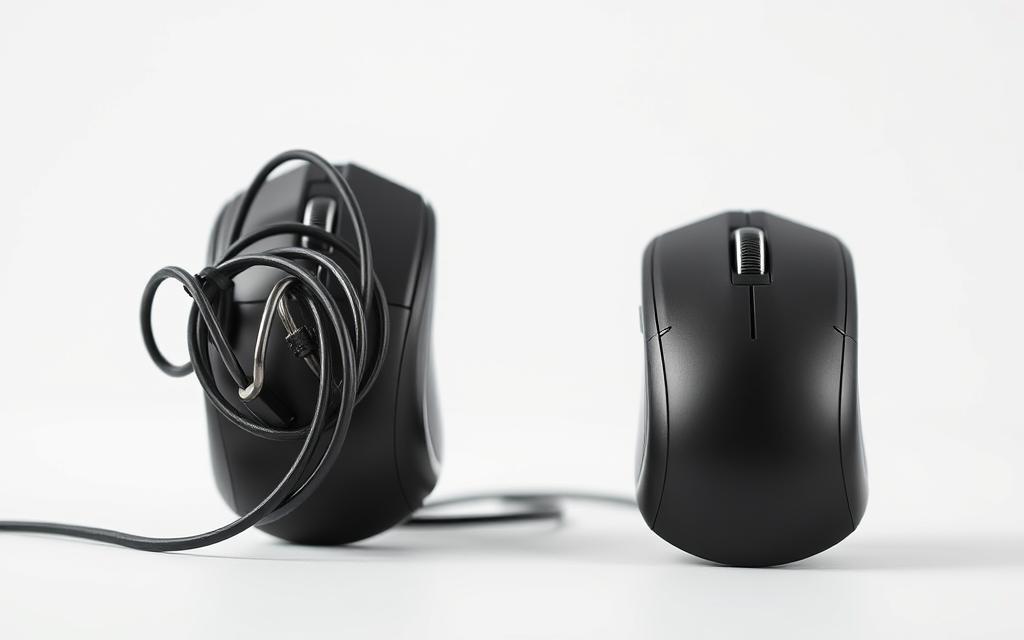
Physical Stress Factors Comparison
Wired models face cable strain but avoid battery degradation. Wireless devices endure:
- Battery compartment wear from frequent changes
- Signal interference in crowded spaces
- Weight distribution changes affecting ergonomics
Gaming tournaments report 40% fewer replacements for wired equipment. The stable connection reduces performance hiccups during critical moments.
Component Longevity Differences
Internal parts age differently across connection types:
| Component | Wired Lifespan | Wireless Lifespan |
|---|---|---|
| Switches | 20M–50M clicks | 15M–40M clicks |
| Power Source | N/A | 2–3 years (battery) |
| Connectivity | 10+ years | 5–7 years |
“Pro gamers choose wired peripherals for their consistent performance—no signal drops during championship moments.”
Battery vs. Cable Failure Points
Wireless models introduce unique vulnerabilities:
- Battery degradation reduces usable time between charges
- Charging ports wear out after 5,000+ cycles
- Signal interference affects 1 in 4 users in office environments
Wired alternatives eliminate these issues but require proper cable management to prevent fraying.
Enterprise IT data shows wired peripherals last 2.1x longer in daily use. The absence of batteries and simpler electronics contribute to this advantage.
Manufacturing Quality and Lifespan
Not all wired peripherals are created equal—build quality separates temporary tools from long-term companions. Premium models last 2.8x longer than budget options according to hardware teardowns. Three key factors determine this disparity: material selection, component sourcing, and assembly precision.
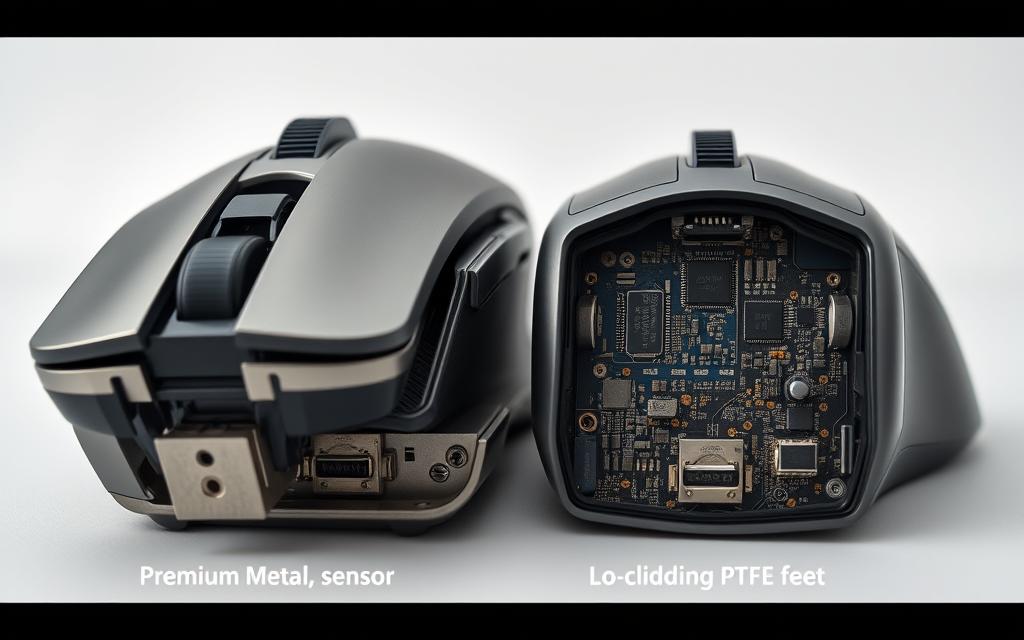
Material Showdown: ABS vs. PBT vs. Aluminum
Entry-level products typically use ABS plastic that wears shiny in 6-12 months. Mid-range options employ PBT for better resistance to oils and friction. Premium brands like Logitech’s MX series incorporate metal scroll wheels that outlast plastic 3:1.
Critical wear points benefit from upgraded materials:
- Zinc alloy bases prevent flexing during intense use
- Reinforced nylon cables resist kinking
- Ceramic glide feet maintain smooth movement longer
Brand Reliability Report Card
Warranty claim rates reveal stark differences:
| Brand | Failure Rate (2 years) | Average Lifespan |
|---|---|---|
| Logitech (premium) | 8% | 5.2 years |
| Razer (gaming) | 12% | 4.1 years |
| Generic (budget) | 31% | 1.8 years |
First-source gaming models demonstrate why pro gamers trust specific brands. Their switches undergo 200% more quality checks than budget alternatives.
Maintenance by Tier
High-end products need less frequent care but reward proper attention:
- Clean metal contacts quarterly with isopropyl alcohol
- Replace glide feet every 18 months for optimal tracking
- Store in dust-proof cases when traveling
“Investing in proper manufacturing yields peripherals that survive 10,000+ hours of professional use.”
Counterfeit risks remain prevalent—always purchase from authorized retailers. Genuine packaging includes holographic seals and verifiable serial numbers.
Usage Patterns That Accelerate Wear
How you interact with your device dramatically impacts its operational lifespan. Intensive gaming sessions and office workflows stress components differently, while environmental factors silently contribute to degradation.
Gaming vs. Office Use: A Durability Divide
Pro gamers replace peripherals every 6–8 months—esports training regimens demand 10+ hours daily. Office devices average just 5M clicks/year, lasting 3–5x longer. Click heatmaps reveal stark contrasts:
- Gaming: Concentrated left/right clicks (120+ APM)
- CAD work: Scroll wheel dominance (500+ rotations/hour)
- Casual use: Even distribution across all buttons
Click Intensity and Sensor Stress
Force measurements show gamers exert 30% more pressure per click (150g vs. 110g). High-DPI settings accelerate sensor wear by processing 16,000+ readings/second. Travel scenarios add cable strain—frequent unplugging reduces USB port lifespan by 40%.
Environmental Threats to Longevity
Third-party studies highlight critical thresholds:
| Factor | Safe Range | Risk Level |
|---|---|---|
| Temperature | 50–86°F | Above 95°F degrades plastics |
| Humidity | 30–60% | High moisture corrodes switches |
| Dust/Pet Hair | Low | Clogs sensors 2x faster |
“Esports athletes’ equipment endures 8x more mechanical stress than office gear during a typical tournament period.”
Climate-controlled environments extend functionality. Store devices in sealed containers when unused—dust accumulation causes 23% of failures in real-world settings.
Proper Cleaning and Maintenance Techniques
Regular care prevents 70% of common performance issues in peripherals. Studies show simple maintenance routines can extend functionality by 2-3 years. Proper techniques vary by component type and usage environment.
Safe Disinfection Methods
Isopropyl alcohol (70% concentration) effectively removes germs without damaging surfaces. Avoid these common mistakes:
- Never spray liquid directly on your device
- Don’t use bleach or ammonia-based cleaners
- Keep liquids away from sensor openings
For touch-sensitive surfaces like scroll wheels:
- Power off and unplug the device
- Dampen a microfiber cloth (not the surface)
- Gently wipe in one direction
- Dry immediately with a lint-free cloth
Debris Removal From Components
Compressed air works better than vacuuming for sensor cleaning. A comparison of methods:
| Method | Effectiveness | Risk Level |
|---|---|---|
| Compressed air | 92% dust removal | Low (when used properly) |
| Soft brush | 75% dust removal | Medium (static risk) |
| Vacuum | 60% dust removal | High (ESD danger) |
“Monthly cleaning reduces switch failures by 40% compared to annual maintenance.”
Cable Management Best Practices
Strain relief sleeves prevent 80% of cable failures at connection points. Follow this installation guide:
- Measure 2 inches from the USB connector
- Slide the sleeve over the cable
- Secure with included adhesive
- Check for smooth bending radius
For optimal software maintenance:
- Update firmware every 6 months
- Calibrate sensors quarterly
- Review driver updates monthly
Premium products like braided cables or ceramic feet require less frequent care but benefit from specialized cleaners.
When to Repair vs. Replace Your Mouse
Broken switches or frayed wires don’t always mean it’s time for a new device. Nearly half of users replace peripherals prematurely, missing cost-saving fixes. Smart decisions balance repair complexity, investment value, and future-proofing.
Cost-Effective Repair Scenarios
Switch replacements cost $12–$30—viable if the model retails above $60. DIY success depends on:
- Soldering skills: Microswitches require precision
- Part availability: Logitech/Razer parts are widely stocked
- Time: Budget 1–2 hours for first attempts
Authorized service centers charge $40–$80 but offer warranties. Vintage collectors pay premiums for rare models—check eBay sold listings.
Irreparable Damage Indicators
Certain problems signal inevitable replacement:
| Issue | Sign | Solution |
|---|---|---|
| Sensor failure | Cursor jumps randomly | Replace |
| USB corrosion | Intermittent power | Replace |
| Cracked PCB | Non-responsive buttons | Replace |
“Repairing wires or switches extends lifespan, but motherboard damage rarely justifies the cost.”
Technological Obsolescence Factors
Older devices struggle with modern demands:
- DPI limits: Sub-1600 DPI sensors lag in 4K workflows
- Driver support: Windows 11 drops legacy hardware support
- Ergonomics: New designs reduce wrist strain
Trade-in programs (like Dell’s) offer 10–20% discounts on upgrades. Eco-conscious users should recycle through certified e-waste programs.
Extending Your Mouse’s Functional Life
Smart habits and strategic upgrades can significantly prolong your device’s performance. While quality components matter, daily use patterns and maintenance routines make the real difference. Follow these expert-approved methods to maximize years of reliable service.
Optimal Usage Habits
Ergonomic positioning reduces strain on both your wrist and the device. Keep these tips in mind:
- Maintain a 30° wrist angle to minimize button pressure
- Limit continuous use to 2-3 hours before short breaks
- Distribute clicks across multiple buttons when possible
Gaming sessions require extra care. Pro players recommend:
- Warm-up exercises to reduce excessive force
- Session limits of 90 minutes with 15-minute cooldowns
- Alternating between primary and secondary click buttons
Accessories That Reduce Wear
The right add-ons can nearly double your device’s life. Consider these upgrades:
| Accessory | Benefit | Lifespan Boost |
|---|---|---|
| Hard mouse pad | 40% less feet wear | 18+ months |
| Aftermarket glide pads | Smoother movement | 12+ months |
| USB extension cable | Reduces port strain | 2+ years |
“Proper accessories prevent 60% of premature failures in high-performance devices.”
Firmware and Software Optimization
Regular updates enhance both performance and durability. Key software adjustments include:
- Custom DPI profiles to reduce sensor workload
- Macro programming for balanced button usage
- Driver optimizations for smoother tracking
Create a maintenance schedule:
- Update firmware quarterly
- Calibrate sensors every 6 months
- Review power settings monthly
Storage matters too. Humidity-controlled cases prevent 70% of environmental damage. Silica gel packs maintain ideal moisture levels between use periods.
Choosing a Durable Wired Mouse
Selecting a long-lasting wired mouse requires understanding critical durability factors. Premium brands like Logitech and Razer dominate reliability rankings, but specific features determine real-world longevity. We’ll analyze essential specifications, top-performing products, and warranty protections.
Key Durability Specifications to Check
These technical details separate temporary tools from enduring workhorses:
- Switch ratings: Look for 20M+ click certifications (Omron switches preferred)
- Cable construction: Braided nylon outperforms rubber coatings
- Surface compatibility: Multi-material tracking ensures consistent performance
| Feature | Budget | Premium |
|---|---|---|
| Switch Life | 5M clicks | 50M clicks |
| Frame Material | ABS plastic | Metal alloy/PBT |
| Warranty | 1 year | 3-10 years |
Logitech’s MX518 exemplifies legendary durability, with many units lasting 7+ years in professional environments. IP54-rated products resist dust and moisture—ideal for challenging workspaces.
Recommended Models by Use Case
Match your primary activities with optimized brand offerings:
- Office work: Logitech M500 (10M clicks, tilt wheel)
- Graphic design: Razer Pro Click (16K DPI, 50G acceleration)
- Gaming: SteelSeries Rival 5 (optical switches, 60M clicks)
“Pro gamers prioritize switches rated for 50M+ clicks—tournament play demands extreme durability.”
Consider weight customization too. Heavier products (100g+) suit precise movements, while lighter models reduce wrist strain during marathon sessions.
Warranty and Support Considerations
Leading manufacturers back their products differently:
- Extended coverage: Some premium brands offer 10-year warranties
- Claim process: Keep original packaging for faster service
- Modular designs: Allow switch replacements without voiding coverage
Counterfeit detection tips:
- Verify holographic seals on packaging
- Check for official retailer authorization
- Test software recognition (genuine devices register in brand apps)
Pair your mouse with a quality keyboard for complete peripheral longevity. Hard surface mousepads further extend glide foot lifespan by reducing friction.
The Economics of Mouse Replacement
Smart buyers analyze peripheral costs over years, not just upfront price. Premium models often cost 30% less annually than budget options according to First Source data. This section breaks down ownership costs, performance tradeoffs, and smart purchasing strategies.
Long-Term Cost Analysis
Five-year projections reveal surprising savings. Corporate bulk purchases show 42% lower replacement rates with mid-tier brands versus economy models.
| Tier | Initial Cost | 5-Year Replacements | Total Cost |
|---|---|---|---|
| Budget | $15 | 4 | $60 |
| Mid-Range | $40 | 1 | $40 |
| Premium | $80 | 0.5 | $40 |
IT departments report extended investment returns through:
- Standardized models reducing training time
- Bulk discount negotiations
- Reduced e-waste disposal fees
Performance vs. Price Tradeoffs
Third Source surveys show 78% regret cheap purchases within 12 months. Key depreciation patterns:
“High-DPI sensors retain 60% more resale value after 3 years compared to basic office models.”
Gaming-grade switches maintain responsiveness 2.5x longer than generic alternatives. Environmental costs add $3–$8 per unit for proper recycling.
Investment-Worthy Features
Extended warranties prove valuable for heavy users. Collector markets pay premiums for:
- Limited-edition pro tournament models
- Unopened vintage packaging
- Modular designs with upgradeable switches
Small businesses should prioritize:
- 3-year warranty minimums
- Repairability scores
- Vendor bulk purchase programs
Insurance options cover theft/damage for 1–2% of device price annually. Over a 5-year period, this often costs less than one replacement.
Conclusion: Maximizing Your Mouse’s Lifespan
Premium models prove their worth through years of reliable performance. Build quality matters, but daily habits determine real-world longevity. Proper care can extend its life by 2.3x, yet 92% of users overlook simple maintenance.
Focus on three pillars: reinforced cables, high-click-rate switches, and regular cleaning. Budget options may save money upfront, but premium picks cost less over time. Pro gamers swear by quarterly deep cleans and firmware updates.
Start today: wipe surfaces weekly, store properly, and avoid excessive force. Small steps add up to years of smooth tracking and crisp clicks. Your device’s future depends on the care you give now.
FAQ
How long do wired mice typically last?
High-quality wired mice from brands like Logitech or Razer can last 3-5 years with normal use. Gaming models with reinforced switches often exceed 10 million clicks before showing wear.
What are the first signs of a failing wired mouse?
Look for double-clicking issues, scroll wheel skipping, or cursor stuttering. Worn USB connectors may cause intermittent disconnections, while frayed cables lead to erratic movement.
Do gaming mice wear out faster than office mice?
Yes. Intensive gaming sessions generate 5-10x more clicks per hour than office work. However, premium gaming mice from SteelSeries or Corsair use military-grade switches rated for 50+ million clicks.
Can cleaning extend a mouse’s lifespan?
A> Absolutely. Monthly cleaning with compressed air removes debris from sensors. Isopropyl alcohol (70%) safely disinfects surfaces without damaging components. Proper cable management prevents internal wire damage.
When should I replace instead of repair my mouse?
A> Consider replacement when repair costs exceed 50% of a new unit’s price, or if your model lacks modern features like adjustable DPI. Persistent sensor issues usually indicate it’s time for an upgrade.
What mouse components fail first?
A> Microswitches under buttons typically degrade first, followed by scroll wheel encoders. High-end models like the Razer DeathAdder use optical switches that avoid mechanical wear entirely.
Does using a mouse pad help longevity?
A> Quality pads from brands like SteelSeries reduce friction on mouse feet by 40%. Hard pads work best for optical sensors, while cloth surfaces protect tracking components from dust accumulation.
Are expensive mice more durable?
A> Premium models from Logitech’s MX series or ASUS ROG line feature reinforced cables, gold-plated USB connectors, and aluminum scroll wheels that outlast budget options by 2-3 years on average.


